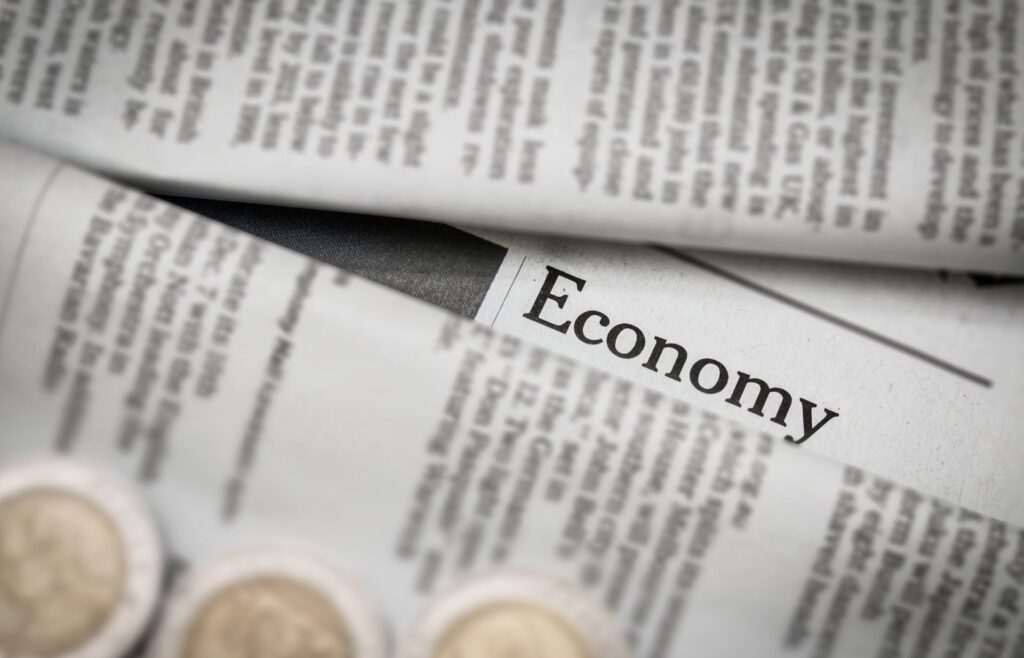It’s easy to look at the Trump administration and point to all the serious economic mistakes it is making. However, economic mistakes do not necessarily lead to a recession and certainly not to a crash, as some critics seem to expect.
In fact, some of the economic mistakes are offsetting. A bad policy in one direction, say big tax cuts for rich people, may offset a bad policy in the other direction, say cutting Medicaid and research funding. The former raises the risk of too much demand, while the latter reduces demand both directly and indirectly. While it is easy to attack both policies, the problems at least from an economic perspective (we don’t need to give rich people more money and power) are largely offsetting, at least in the near term.
Before looking more closely at the economic picture at the Trump administration’s six-month mark, it’s worth stepping back and reminding everyone how slowly a disaster can be in developing. I was watching the housing bubble grow from 2002. It was clear that it was driving the economy, both from a huge surge in housing construction and also from consumption driven by the housing equity generated by the bubble.
Having first been convinced that the run-up in prices was a bubble in the summer of 2002, as in not driven by the fundamentals in the housing market, I expected that it would soon peak and start to reverse course as the stock bubble did in 2000. Contrary to my expectations, it continued to grow until the summer of 2006.
Prices grew far higher than they had been in 2002 when I first became convinced of the bubble. The bad lending practices that were already visible in 2002 exploded to the point where they had become a joke within the industry. People in housing finance openly talked about “liar loans” and NINJA loans, which stood for “no job, no income, no assets.”
To be clear, the lying was driven at least as much by the lenders as the borrowers. We had created a system of securitization where the profit was derived from issuing the loan, not from having a homeowner who would repay it. Mortgage issuers were happy to issue loans that they had no reason to expect would be repaid because they knew they could resell just about anything in the secondary market.
Anyhow, the fun pretty much ended by the summer of 2006. That was when the subprime market largely froze, and house prices began to drift lower. However, the economy remained healthy, growing 2.8 for the full year. The growth even continued through most of 2007, which registered 2.0 percent growth for the full year.
We stopped creating jobs in December of 2007 and the recession gradually gained speed in 2008 as the trickle of bank failures turned into a monsoon. By October, we had the Treasury Secretary, accompanied by the Fed chair and head of the New York Federal Reserve Bank, running to Congress demanding hundreds of billions to bail out the banks, warning that without the money, it would be the end of capitalism.
This was a long trip down memory lane, but the point is that even when you have a clearly disastrous situation, it takes a long time for the impact to be felt. The U.S. economy is often compared to an oil tanker at sea, which takes many miles to slow and bring to a stop. Even that analogy probably understates the force of economic momentum, and the U.S. economy had lots of momentum going into 2025, a point that even the media can acknowledge now that the election is behind us.
Where Are We Now?
It’s a bit bizarre that many commentators talk as though the economy is still sailing along just fine. While we are not in a recession, the economy did shrink by 0.5 percent in the first quarter. There were unusual factors driving that fall. Imports soared as households and businesses stocked up on imported goods ahead of anticipated tariffs. But there is no way that anyone can beat up the data for the quarter and come up with a good story.
Job creation has slowed sharply. We had been creating jobs at a 170,000 monthly rate through 2024. In the first six months of this year job growth averaged just 130,000 a month. To be clear, this slowing is largely due to the tightening immigration restrictions, which began last June under Biden, but it still translates into slower growth in demand and the economy.
There also is some evidence that wage growth has slowed. The annualized rate of growth, comparing the last three months (April-June) with the prior three (January-March) is just 3.2%, down from a 4.0 percent pace in 2024. This averaging is my preferred measure of wage growth, since it reduces the impact of a single month’s data, which is erratic. Nonetheless, the extent of slowing may look different with another month’s data.
There is also some evidence that tariffs are starting to have an impact on inflation. While the Consumer Price Index (CPI) is still relatively tame, the downward trend we saw through 2024 seems to have been reversed. June was the first month where the government collected substantial revenue from Trump’s tariffs, pulling in $26 billion compared to $6 billion last June.
The difference of $20 billion comes to $240 billion annually, which makes it one of the largest tax increases in history. Summing this over ten years, as is the standard in budget calculations, it comes to $2.4 trillion. On a per household basis this comes to $1,900 a year or $19,000 over a decade. That’s real money for most people.
And just to be clear, exporters are not paying the tariffs. If exporters were paying the tariff there would be a fall in import prices. (These are measured before the tariff.) Import prices have been rising this year, pretty much on the same course as last year. That means someone here; the importers, retailers, or consumers, will be paying the tariffs.
The June CPI showed big rises in the prices of apparel, appliances and other home furniture, and audio and visual equipment. These increases did not reflect anywhere near the full effect of the tariffs. This is in part because retailers built up huge inventories in anticipation of the tariffs and are selling down those inventories before raising prices.
The other factor is that many companies, notably auto manufacturers, are waiting to see if tariffs stick before raising prices. They might be willing to absorb smaller margins for a period of time rather than lose market share, but over time, this will almost certainly not be the case if the tariffs remain in place.
The tariffs will be a major drag on demand in the second half of 2025 and beyond, especially if Trump goes through with the higher tariffs he has proposed for August 1.
In this respect, it is worth noting that real wages edged down by 0.1 percent in July. This decline is trivial in itself, but the combination of slowing nominal wage growth from a weakening labor market and higher inflation due to tariffs, will dampen or reverse the real wage growth we had been seeing and crimp consumption.
Tariffs will also be hitting manufacturing. Close to half our imports are inputs to production. Tariffs on items used in manufacturing, like Trump’s 50 percent tariff on imported steel, are a big hit to automobile production and other industries. If these tariffs stay in place, the impact of higher costs is likely to swamp any plausible incentive to domestic production from the tariffs.
The Trump tariffs should ensure that the Biden factory boom (real construction was more than twice as high in 2024 than in 2019) fades quickly. The factories that were being built as a result of the Infrastructure bill, the CHIPS Act, and the Inflation Reduction Act, may get finished (some may not), but it is unlikely many new projects will be started in the current environment.
The economic hit from the tariffs will be amplified by the hit from the budget cuts. These are mostly in health care, education, and research. The health care cuts have been well-publicized. The Republican budget projects more than $800 billion in cuts to Medicaid over the next decade, roughly 10 percent of projected spending in the program and a bit less than 1.0 percent of total spending.
While most of these cuts are not supposed to hit until the end of 2026 (after the election), we are already beginning to see their impact, along with the impact of cuts to the subsidies for the Obamacare exchanges. Hospitals and other providers have to budget for the future. They know the revenue they will be receiving will be sharply lower than what they had previously expected.
This means curtailing expansion plans in some cases. In others it means downsizing or even closing. Rural hospitals were already seriously stretched, with over 100 forced to close over the last decade. That process will accelerate due to the Republican cuts, both depriving people of access to healthcare and costing jobs in many communities.
The workers that Trump is deporting will also be a factor here. Many immigrants worked in low-paying jobs in the healthcare sector. Hospitals, nursing homes, and other facilities will struggle to replace them and will almost certainly have to pay more money when they do. This will also accelerate the loss of hospitals and other providers. It is worth noting that healthcare has been by far the leading sector for job growth in the last three years. Budget cuts and the loss of immigrant labor will sharply slow growth in the sector.
The loss of immigrant labor is also likely to cost jobs in construction. While to some extent immigrant workers replaced native born workers, they often provided a necessary source of labor that allows projects to go forward. The net effect of having fewer immigrants working in construction is likely to be less construction and fewer jobs in the sector for native born workers.
There is likely to be a similar effect in the hotel and restaurant industry, as the loss of immigrant labor makes it more expensive for these businesses to operate. With the tourism industry already taking a hit due to a plunge in foreign visitors, there will likely be weak job growth in this sector in the second half of this year and beyond.
The loss of immigrant labor will have the largest effect in agriculture. There is no plausible story where native born workers will substitute for any substantial portion of the immigrants working in agriculture. There are many accounts of farm workers being detained by ICE. Also, many are not coming to work in fear of being arrested.
We will know the impact later this summer as crops, especially fruits and vegetables, go unharvested. This effect will be amplified by Trump’s tariffs, especially the 17 percent tariff on Mexican tomatoes that took effect this month. This will mean higher prices at the grocery store and lower real wages.
Trump’s assault on universities, both by withholding funds to push his “anti-woke” agenda and cuts to research spending is likely to have a major impact on this sector, which is already being felt. The private portion of the education sector had been adding an average of 7,000 jobs a month in 2024. It lost 7,500 jobs in June. We are likely to see further job losses through 2025 and into next year, as schools impose layoffs and reduce hiring. Stricter rules on student loans will also have an impact, but that will be more visible next year as fewer people are able to afford school.
There will also be a long-run effect from cuts to universities, as well as the direct cuts in research by the National Institutes of Health and other government agencies. The United States was at the cutting edge in biomedical research and many other areas. This will no longer be true after these budget cuts, as many leading researchers take jobs in other countries. However, this effect will mostly be seen a few years out, as we pay to import technology that we otherwise would have developed here.
The Financial Markets: A Misplaced Focus
There has been much made of the reactions to Trump’s policies in financial markets, especially the plunges in the stock market in response to announcements of big tariff hikes. It seems that the stock market has reconciled itself to high tariffs, although investors may still believe that Trump will back down yet again. Either way, it doesn’t really matter much for the economy.
While the plunge in the markets made for good headlines and lots of hysterics about people’s retirement savings being destroyed, even at its lowest point on “Liberation Day I” the S&P 500 was still almost 70% higher than its level of five years ago. In other words, people with 401(k)s still had far more money in the stock market than they had any reasonable right to expect five years ago. The stock market could of course go lower, and since it is very high relative to earnings by historic standards, we may see a serious correction, but the ups and downs from the spring were more theater than anything else.
Many analysts have made a bigger deal out of the movements in the dollar and the bond market, under the assumption that these are driven more by professional investors who understand the fundamentals. The story with the dollar is that investors are fleeing the dollar because they no longer have confidence in the competence of the U.S. government or its commitment to the rule of law. In the case of Treasury bonds, the story is that yields have remained relatively high because investors are concerned that tariffs will lead to inflation. Also, they worry that Trump will eventually gain control of the Fed and demand that it abandon efforts to combat inflation.
There is considerable truth to both of these claims, but the impacts are exaggerated. Holding dollars or dollar assets as a safe haven is not a zero-one proposition. Trump’s actions certainly make dollar-based assets less attractive relative to assets in other currencies, but he would have to take far more extreme measures to cause all investors to flee. Given Trump’s lack of respect for the rule of law, a massive flight is still possible, but the drop to date is not a very big deal.
The dollar is roughly 15 percent lower today than when Trump took office. That is a substantial drop in six months, but it has been lower in the recent past. For example, at the start of 2021 it was around 5 percent lower against the euro than it is today. It is still about 20 percent higher than it was in the summer of 2008. This is a case where the fall should be taken seriously and if the dollar were to continue to drop at anything like the rate it did in the first half of 2025 it would be a very big deal. But the drop we have seen to date is not catastrophic and not hugely noteworthy, except as a warning, just as the sharp rise in the dollar in 2021 and 2022 did not get much attention.
There is a similar story with the bond market. It would be nice to see a lower interest rate on Treasury bonds than the current 4.43 percent, and the rate would almost certainly be lower if not for Trump’s tariffs and erratic behavior. However, this is not an especially high interest rate. In the late 1990s, when everyone was celebrating Bill Clinton’s budget surpluses, the interest rate bottomed out at just about the same level and was mostly over 5 percent. And with inflation today running well above the late 1990s levels, real interest rates are considerably lower than in our last era of budget surpluses.
The rhetoric around Trump’s budget deficits has been seriously overheated. More tax cuts for the rich are horrible policy, but most of the cost from his tax cuts was due to continuing tax cuts that were already in place. These tax cuts were scheduled to expire but leaving them in place does not increase current deficits. And the cuts Trump has put in place to research, universities, Medicaid, and other healthcare spending, coupled with substantial tariff revenue, will lead to lower deficits. This may be bad policy in terms of its impact on people now and its longer-term impact on the economy, but the problem is not large deficits.
The Trump Slowdown
Throwing this all together, the Trump policies look like a recipe for a slowing economy, but not necessarily a recession. His policies virtually guarantee the slowing of major growth areas for the economy, specifically healthcare, state and local government, the hotel and restaurant industry, and private colleges and universities. There is no obvious area that can fill the gap this slowing will create.
Trump’s dream for a revitalized manufacturing sector are largely just dreams. There was the beginning of a surge in clean energy and EV production under Biden, but Trump seems determined to wipe it out. We are not likely to see a jump in fossil fuel production or the manufacture of traditional internal combustion (IC) cars to fill the gap.
At current prices, new drilling for oil and gas is just marginally profitable. Unless prices take a big jump there will not be a noticeable uptick in oil and gas production regardless of how much land Trump opens to the industry. IC cars are expensive. There could always be a modest uptick in consumption, but killing the EV industry will not lead to a boom in demand.
With real wage growth slowing, if not coming to a halt altogether, consumption growth is likely to slow in the second half of 2025 and beyond. Increased payments on student loans will also dampen demand. Also, Trumpian uncertainty is likely to be a major impediment to investment, as businesses have no idea where tariffs will be in a few months or a few years.
Taken together, this seems to be a recipe for a slowing economy through 2025, which could slip into negative growth in 2026. The classic virtuous circle would run in reverse. A weakening labor market would lead to slower nominal wage growth. This would translate into even slower or negative real wage growth as tariffs push prices higher. This would slow consumption, leading to further weakening of the labor market and the pace of nominal wage growth. This is not a story of collapse, but it is also not a happy picture for the economy and working people.
The Possibility of Surprises
It’s hard to see what upside surprises there can be in this story. Maybe the rest of the world will suddenly start to buy American because they are so impressed by Trump’s wisdom, but that hardly seems likely. The more likely prospect is that we see a further hit to demand as our trading partners impose retaliatory measures designed to inflict as much pain as possible. If Trump responds by jacking up our import taxes even higher, look to still more inflation and disruptions to the U.S. economy.
There are some obvious potential downside surprises. The new legislation on crypto is virtually inviting corruption. Regulation of banks has always been problematic. And this is not ancient history. It was just a bit over two years ago that the geniuses running Silicon Valley Bank discovered that bond prices fall when interest rates rise. That bailout cost taxpayers $20 billion. Among the leading advocates for that bailout was David Sachs, Trump’s crypto czar.
A major meltdown of a crypto coin could lead to a panic in the crypto market. If that stays confined to the crypto sector, we can all just pass the popcorn and enjoy the show. But if it spreads to the banking system as a whole, the impact would be hard to predict.
The other obvious risk is a collapse of the AI boom. It is not clear if any of the companies racing to gain the lead in AI technology is actually looking at a pot of gold at the end of the effort. If that becomes clear to investors, as happened with the Internet bubble in 2000, stock prices can fall even more rapidly than they rose.
The plunge in stock prices, which is likely to hit the broader market, coupled with plunging investment in AI, could very well give us a recession. And contrary to conventional wisdom, recessions caused by collapsing stock bubbles can be bad news. While the conventional view of the 2001 recession that followed the collapse of the bubble is that it was short and mild, we didn’t get back the jobs lost for four full years. At the time, that was the longest period without positive job growth since the Great Depression. (It took longer to recover the jobs lost during the Great Recession following the collapse of the housing bubble.) So a collapse of the AI boom could have very serious implications for the economy.
The Immediate Future: Q2 Should be Fine
We will get the GDP data for the second quarter at the end of the month. This is likely to show respectable growth, most likely between 2.0-2.5 percent. The important point to keep in mind in evaluating this data is that it follows a quarter where GDP reportedly fell by 0.5 percent.
Any serious analysis has to average these two together, since they are obviously connected. We will see a big fall in the trade deficit provided a large boost to growth in the second quarter, but that is due to the large jump in the first quarter that subtracted 1.6 percentage points from GDP growth in the quarter. An average growth rate through the first half of 2025 in the range of 1.0 to 1.5 percent does not look very impressive, and as I have argued, there are good grounds for thinking it will go lower in the second half of the year.
The July jobs report is likely to show further weakening. There was an extraordinary jump in state and local government employment in education in June. This was due to faulty seasonal adjustments that will not be repeated in July and may be partially reversed. The July jobs report should make the slowing in job growth more apparent. In any case, the data picture will be much clearer in the next two weeks.
source: CEPR




